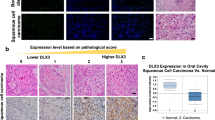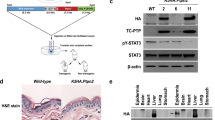Abstract
The levels of 8S-lipoxygenase (8S-LOX) expression and of its arachidonic acid metabolite, 8-hydroxyeicosatetraenoic acid (8-HETE), are highly elevated in the early stages of mouse skin carcinogenesis. On the other hand, several reports showing that 8-HETE is also closely associated with keratinocyte differentiation raise a question concerning the role of 8S-LOX/8-HETE in skin carcinogenesis. To address that question, here we conducted a series of gain-of-function studies. Skin targeted loricrin 8S-LOX/C57BL/6J transgenic mice showed a more differentiated epidermal phenotype as well as a 64% reduced papilloma development in a two-stage skin carcinogenesis protocol. Forced expression of 8S-LOX in MT1/2 cells, a murine papilloma cell line, also caused a more differentiated appearance as well as keratin 1 expression. Overexpression of 8S-LOX in CH72 cells, a murine carcinoma cell line, inhibited cell proliferation by 30% in vitro and by 86% in in vivo xenografts. Exogenous addition of 5 μ M 8-HETE to CH72 cells caused cell cycle arrest at the G1 phase. Finally, immunohistochemical analyses showed 8S-LOX protein expression was strictly confined to the differentiated compartment of mouse skin and throughout tumorigenesis. Collectively, these data suggest that 8S-LOX plays a role as a prodifferentiating, antitumorigenic, and tumor suppressing gene in mouse skin carcinogenesis.
This is a preview of subscription content, access via your institution
Access options
Subscribe to this journal
Receive 50 print issues and online access
$259.00 per year
only $5.18 per issue
Buy this article
- Purchase on Springer Link
- Instant access to full article PDF
Prices may be subject to local taxes which are calculated during checkout









Similar content being viewed by others
Abbreviations
- AA:
-
arachidonic acid
- COX:
-
cyclooxygenase
- PG:
-
prostaglandin
- LOX:
-
lipoxygenase
- HETE:
-
hydroxyeicosatetraenoic acid
- HODE:
-
hydroxyoctadecadienoic acid
- LA:
-
linoleic acid
- TPA:
-
12-O-tetradecanoylphorbol-13-acetate
- PPAR:
-
peroxisome proliferator-activated receptor
- K1:
-
keratin 1
- DMBA:
-
dimethylbenz[a]anthracene
- EMEM:
-
Eagle's minimal essential medium
- FBS:
-
fetal bovine serum
- GAPDH:
-
glyceraldehyde 3-phosphate dehydrogenase
- TTBS:
-
Tween 20 Tris-buffered saline
- BHT:
-
butylated hydroxytoluene
- PBS:
-
phosphate-buffered saline
- LC/MS/MS:
-
liquid chromatography/tandem mass spectrometry
- H&E:
-
hematoxylin and eosin
- TUNEL:
-
terminal deoxynucleotidyl transferase-mediated deoxyuridine triphosphate nick end-labeling
- BrdU:
-
5-bromo-2′-deoxyuridine
- SSR:
-
simple sequence repeat
References
Bhatia B, Maldonado CJ, Tang S, Chandra D, Klein RD, Chopra D, Shappell SB, Yang P, Newman RA and Tang DG . (2003). J. Biol. Chem., 278, 25091–25100.
Brash AR . (1999). J. Biol. Chem., 274, 23679–23682.
Brash AR, Boeglin WE and Chang MS . (1997). Proc. Natl. Acad. Sci. USA, 94, 6148–6152.
Bürger F, Krieg P, Kinzig A, Schurich B, Marks F and Fürstenberger G . (1999). Mol. Carcinogen., 24, 108–117.
Conti CJ, Fries JW, Miller DR and Slaga TJ . (1988a). Cancer Res., 48, 435–439.
Conti CJ, Fries JW, Viaje A, Miller DR, Morris R and Slaga TJ . (1988b). Cancer Res., 48, 435–439.
DiGiovanni J . (1992). Pharmacol. Ther., 54, 63–128.
DuBois RN . (2003). J. Natl. Cancer Inst., 95, 1028–1029.
Fischer SM, Baldwin JK, Jasheway DW, Patrick KE and Cameron GS . (1988). Cancer Res., 48, 658–664.
Fischer SM, Fürstenberger G, Marks F and Slaga TJ . (1987). Cancer Res., 47, 3174–3179.
Fischer SM, Jasheway DW, Klann RC, Butler AP, Patrick KE, Baldwin JK and Cameron GS . (1989). Cancer Res., 49, 6693–6699.
Fischer SM and Klein RD . (2004). Lipoxygenases as Targets for Cancer Prevention. Humana Press Inc.: Totowa.
Fischer SM, Mills GD and Slaga TJ . (1982). Carcinogenesis, 3, 1243–1245.
Fosslien E . (2000). Crit. Rev. Clin. Lab. Sci., 37, 431–502.
Fürstenberger G, Hagedorn H, Jacobi T, Besemfelder E, Stephan M, Lehmann W-D and Marks F . (1991). J. Biol. Chem., 266, 15738–15745.
Fürstenberger G, Marks F and Krieg P . (2002). Prostaglandins Other Lipid Mediat., 68–69, 235–243.
Gschwendt M, Fürstenberger G, Kittstein W, Besemfelder E, Hull WE, Hagedorn H, Opferkuch HJ and Marks F . (1986). Carcinogenesis, 7, 449–455.
Guo Y, Zhao J, Sawicki J, Soler AP and O'Brien TG . (1999). Mol. Carcinogen., 26, 32–36.
Hanley K, Jiang Y, He SS, Friedman M, Elias PM, Bikle DD, Williams ML and Feingold KR . (1998). J. Invest. Dermatol., 110, 368–375.
Hohl D, Lichti U, Breitkreutz D, Steinert PM and Roop DR . (1991). J. Invest. Dermatol., 96, 414–418.
Hsi LC, Wilson LC and Eling TE . (2002). J. Biol. Chem., 277, 40549–40556.
Huitfeldt HS, Heyden A, Clausen OPF, Thrane EV, Roop DR and Yuspa SH . (1991). Carcinogenesis, 12, 2063–2067.
Jack GS, Brash AR, Olson SJ, Manning S, Coffey CS, Smith JAJ and Shappell SB . (2000). Hum. Pathol., 31, 1146–1154.
Jisaka M, Kim RB, Boeglin WE, Nanney LB and Brash AR . (1997). J. Biol. Chem., 272, 24410–24416.
Kartasova T, Roop DR and Yuspa SH . (1992). Mol. Carcinogen., 6, 18–25.
Kashiwagi M, Ohba M, Chida K and Kuroki T . (2002). J. Biochem. (Tokyo), 132, 853–857.
Kelavkar UP, Nixon JB, Cohen C, Dillehay D, Eling TE and Badr KF . (2001). Carcinogenesis, 22, 1765–1773.
Kempen EC, Yang P, Felix E, Madden T and Newman RA . (2001). Anal. Biochem., 297, 183–190.
Kömüves LG, Hanley K, Lefebvre AM, Man MQ, Ng DC, Bikle DD, Williams ML, Elias PM, Auwerx J and Feingold KR . (2000). J. Invest. Dermatol., 115, 353–360.
Mahé YF . (1998). Int. J. Dermatol., 37, 416–417.
Marks F, Müller-Decker K and Fürstenberger G . (2000). Toxicology, 153, 11–26.
Muga SJ, Thuillier P, Pavone A, Rundhaug JE, Boeglin WE, Jisaka M, Brash AR and Fischer SM . (2000). Cell Growth Differ., 11, 447–454.
Nair J, Fürstenberger G, Bürger F, Marks F and Bartsch H . (2000). Chem. Res. Toxicol., 13, 703–709.
Naito M and DiGiovanni J . (1989). Genetic Background and Development of Skin Tumors. Raven Press: New York.
Nakadate T, Yamamoto S, Ishii M and Kato R . (1982). Carcinogenesis, 3, 1411–1414.
Nelson KG and Slaga TJ . (1982). Cancer Res., 42, 4176–4181.
Nie D, Hillman GG, Geddes T, Tang K, Pierson C, Grignon DJ and Honn KV . (1998). Cancer Res., 58, 4047–4051.
Nischt R, Roop DR, Mehrel T, Yuspa SH, Rentrop M, Winter H and Schweizer J . (1988). Mol. Carcinogen., 1, 96–108.
Prigge ST, Boyington JC, Faig M, Doctor KS, Gaffney BJ and Amzel LM . (1997). Biochimie, 79, 629–636.
Rückert R, Lindner G, Bulfone-Paus S and Paus R . (2000). Br. J. Dermatol., 143, 1036–1039.
Ruzicka T and Printz MP . (1984). Rev. Physiol. Biochem. Pharmacol., 100, 121–160.
Shappell SB, Boeglin WE, Olson SJ, Kasper S and Brash AR . (1999). Am. J. Pathol., 155, 235–245.
Shappell SB, Gupta RA, Manning S, Whitehead R, Boeglin WE, Schneider C, Case T, Price J, Jack GS, Wheeler TM, Matusik RJ, Brash AR and Dubois RN . (2001a). Cancer Res., 61, 497–503.
Shappell SB, Keeney DS, Zhang J, Page R, Olson SJ and Brash AR . (2001b). J. Invest. Dermatol., 117, 36–43.
Sheu MY, Fowler AJ, Kao J, Schmuth M, Schoonjans K, Auwerx J, Fluhr JW, Man M-Q, Elias PM and Feingold KR . (2002). J. Invest. Dermatol., 118, 94–101.
Shureiqi I, Jiang W, Zuo X, Wu Y, Stimmel JB, Leesnitzer LM, Morris JS, Fan HZ, Fischer SM and Lippman SM . (2003). Proc. Natl. Acad. Sci. USA, 100, 9968–9973.
Shureiqi I and Lippman SM . (2001). Cancer Res., 61, 6307–6312.
Shureiqi I, Xu X, Chen D, Lotan R, Morris JS, Fischer SM and Lippman SM . (2001). Cancer Res., 61, 4879–4884.
Sisskin EE, Gray T and Barrett JC . (1982). Carcinogenesis, 4, 403–407.
Slaga TJ . (1984). Mechanisms Involved in Two-Stage Carcinogenesis in Mouse Skin. CRC Press Inc.: Boca Raton, FL.
Stanbridge EJ, Der CJ, Doersen CJ, Nishimi RY, Peehl DM, Weissman BE and Wilkinson JE . (1982). Science, 215, 252–259.
Steele VE, Holmes CA, Hawk ET, Kopelovich L, Lubet RA, Crowell JA, Sigman CC and Kelloff GJ . (1999). Cancer Epidemiol. Biomarkers Prev., 8, 467–483.
Steinbach G, Lynch PM, Phillips RK, Wallace MH, Hawk E, Gordon GB, Wakabayashi N, Saunders B, Shen Y, Fujumura T, Su LK and Levin B . (2000). N. Engl. J. Med., 342, 1946–1952.
Tang DG and Honn KV . (1994). Ann. NY Acad. Sci., 744, 199–215.
Tang S, Bhatia B, Maldonado CJ, Yang P, Newman RA, Liu J, Chandra D, Traag J, Klein RD, Fischer SM, Chopra D, Shen J, Zhau HE, Chung LW and Tang DG . (2002). J. Biol. Chem., 277, 16189–16201.
Thuillier P, Anchiraico GJ, Nickel KP, Maldve RE, Gimenez-Conti I, Muga SJ, Liu K-L, Fischer SM and Belury MA . (2000). Mol. Carcinogen., 29, 134–142.
Toftgård R, Yuspa SH and Roop DR . (1985). Cancer Res., 45, 5845–5850.
Verma AK, Ashendel CL and Boutwell RK . (1980). Cancer Res., 40, 308–315.
Warner TD and Mitchell JA . (2004). FASEB J., 18, 790–804.
Yu K, Bayona W, Kallen CB, Hardings HP, Ravera CP, McMahon G, Brown M and Lazar MA . (1995). J. Biol. Chem., 270, 23975–23983.
Yuspa SH . (1985). Cellular Molecular Changes During Chemical Carcinogenesis in Mouse Skin Cells. Raven Press: New York.
Zietkiewicz E, Rafalski A and Labuda D . (1994). Genomics, 20, 176–183.
Acknowledgements
We greatly appreciate Drs Philippe Thuillier and Russell D Klein for providing helpful advice and guidance. We also would like to give special appreciation to the Histology and Tissue Processing Facility Core and Cell and Tissue Analysis Facility Core at The University of Texas MD Anderson Cancer Center-Science Park, Research Division. We gratefully acknowledge Dr Howard Thames at the University of Texas MD Anderson Cancer Center for assistance in statistical analysis. The assistance of Amy Pavone for technical advice and Carol Mikulec for cell culture are also deeply appreciated. This work was supported by Grants CA16672, CA83794, and CA100140 from the NCI and ES07784 from the NIEHS.
Author information
Authors and Affiliations
Corresponding author
Rights and permissions
About this article
Cite this article
Kim, E., Rundhaug, J., Benavides, F. et al. An antitumorigenic role for murine 8S-lipoxygenase in skin carcinogenesis. Oncogene 24, 1174–1187 (2005). https://doi.org/10.1038/sj.onc.1208269
Received:
Revised:
Accepted:
Published:
Issue Date:
DOI: https://doi.org/10.1038/sj.onc.1208269
Keywords
This article is cited by
-
Distinct differences in serum eicosanoids in healthy, enteritis and colorectal cancer individuals
Metabolomics (2018)
-
Structural and biochemical changes underlying a keratoderma-like phenotype in mice lacking suprabasal AP1 transcription factor function
Cell Death & Disease (2015)
-
Transgenic expression of 15-lipoxygenase 2 (15-LOX2) in mouse prostate leads to hyperplasia and cell senescence
Oncogene (2010)
-
Lipoxygenase metabolism: roles in tumor progression and survival
Cancer and Metastasis Reviews (2007)
-
Epidermal Lipoxygenase Products of the Hepoxilin Pathway Selectively Activate the Nuclear Receptor PPARα
Lipids (2007)



